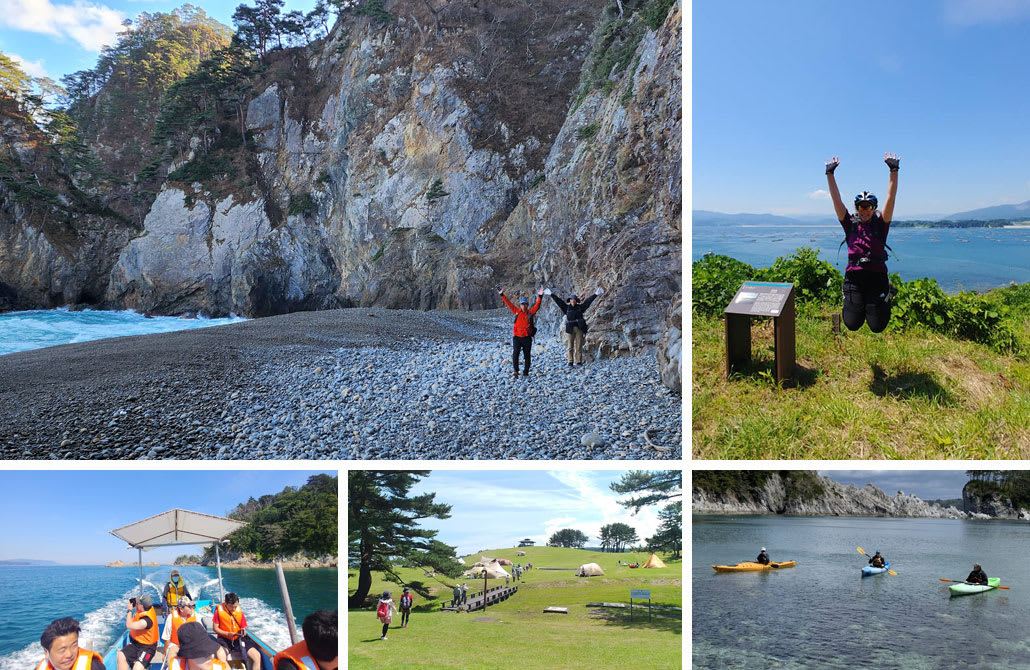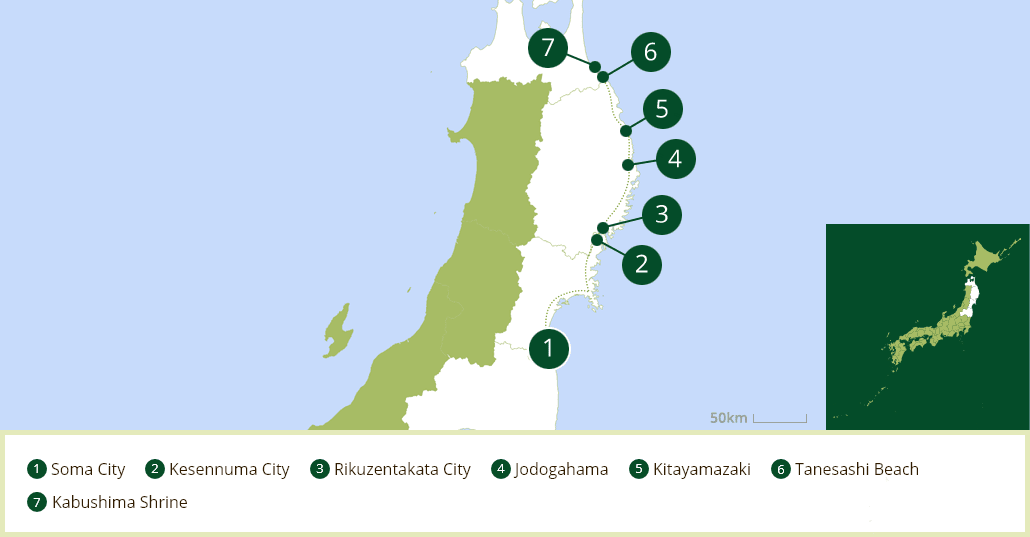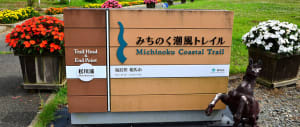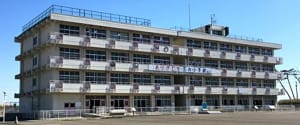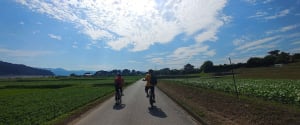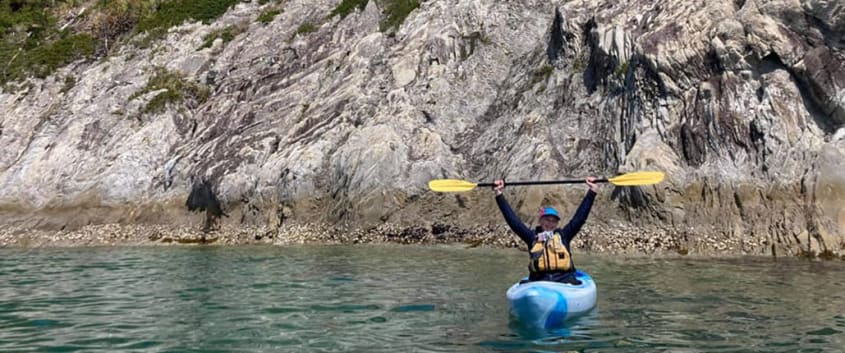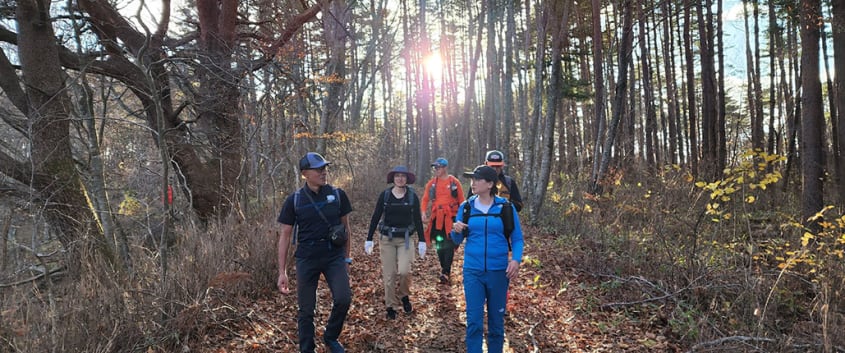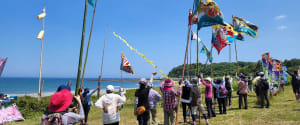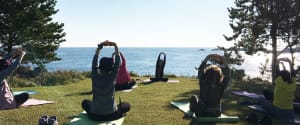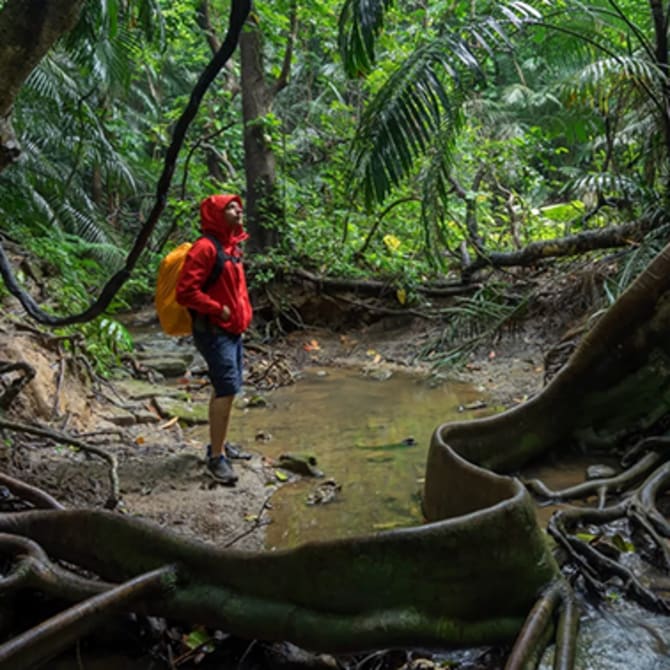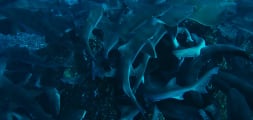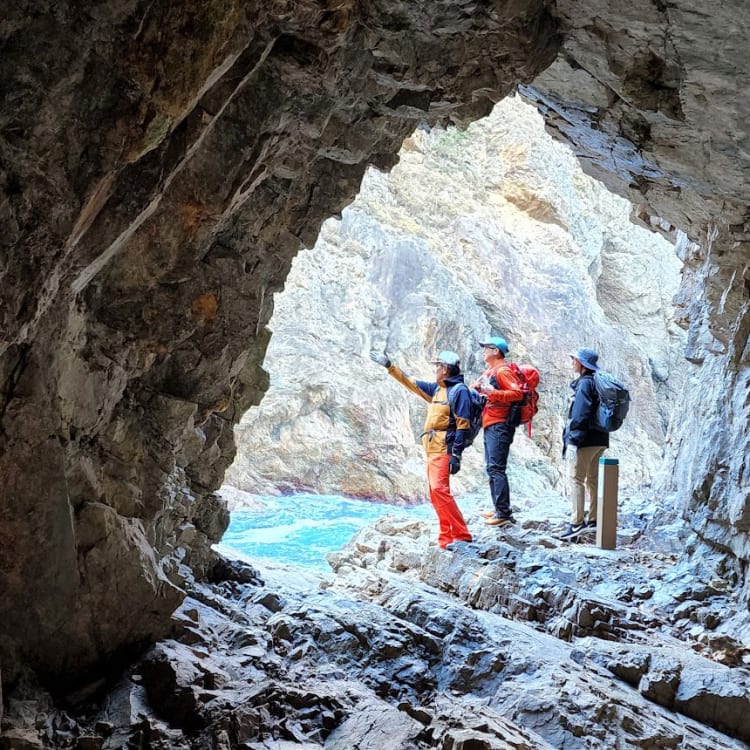
Recommended Route Tohoku (Aomori, Iwate and Miyagi)
Day 1
The Origins of the Michinoku Coastal Trail and Start the Journey
Your trip begins at Sendai Station in Miyagi Prefecture, the gateway to northern Japan. It takes about 1 hour and 30 minutes by Shinkansen from Tokyo and can also be accessed from Sendai International Airport. After meeting your tour coordinator, the first thing to do is take a bus to the Natori Trail Center in Natori City. The Michinoku Coastal Trail is a trail route developed by the Ministry of the Environment to convey the recovery from the Great East Japan Earthquake that occurred on March 11, 2011. In June 2019, the entire route opened as a national trail with a total length of over 1,000 km. You will start by receiving an introduction to grasp the concepts surrounding the creation of the route as a whole and learn about the characteristics of the area it covers and set the scene for the adventure that lies ahead.
After that, you will board the bus again and head south to Soma City, Fukushima Prefecture, the starting point of the Michinoku Coastal Trail . After a quick commemorative picture at the trail head, you will start the tour with a hike around the Soma area.
Today's route shows the history and culture of Soma City, which flourished as a castle town. You will start from the Matsukawaura park, which was completely destroyed due to the tsunami, but was rebuild thanks to the help of volunteers from around the world. This route also takes us past the castle ruins as well as many shrines and Kannon statues that are believed to continue to protect the town. You can learn about the history of this town as you walk through the changing scenery.
During the hike, you will grab a lunch box from a local restaurant and enjoy it near the
former castle park in Soma city during the hike.
Lunch :
Today's lunch will be a lunch box with rice and the Soma beef mince cutlets prepared by a local delicatessen, Torikyu Seinikuten, in Soma city. They specialize in making various dishes using Soma brand beef, and the mince cutlets are particularly popular with the locals.
After hiking through Soma city, we will transfer to the area of Watari, in southern Miyagi Prefecture and stay overnight at the Watari Onsen Torinoumi Hotel. This hotel was destroyed by the tsunami, but since rebuilt and serves as a symbol of resilience for the local area.
As the first day, the focus will be on intuitively grasping the scars caused by the earthquake and learning how the city is recovering through our main activity of hiking .
Dinner :
Dinner will be a Japanese set meal consisting of local seafood and other ingredients from the area.
Accommodation :
You will be staying at Watari Onsen Torinoumi. Located along the coastline, you can enjoy views of the Pacific Ocean from the hot springs bath and restaurant. You can choose between a twin-share western room or a Japanese-style room with a private bath and toilet. Hot spring facilities are also available at the hotel.
After that, you will board the bus again and head south to Soma City, Fukushima Prefecture, the starting point of the Michinoku Coastal Trail . After a quick commemorative picture at the trail head, you will start the tour with a hike around the Soma area.
Today's route shows the history and culture of Soma City, which flourished as a castle town. You will start from the Matsukawaura park, which was completely destroyed due to the tsunami, but was rebuild thanks to the help of volunteers from around the world. This route also takes us past the castle ruins as well as many shrines and Kannon statues that are believed to continue to protect the town. You can learn about the history of this town as you walk through the changing scenery.
During the hike, you will grab a lunch box from a local restaurant and enjoy it near the
former castle park in Soma city during the hike.
Lunch :
Today's lunch will be a lunch box with rice and the Soma beef mince cutlets prepared by a local delicatessen, Torikyu Seinikuten, in Soma city. They specialize in making various dishes using Soma brand beef, and the mince cutlets are particularly popular with the locals.
After hiking through Soma city, we will transfer to the area of Watari, in southern Miyagi Prefecture and stay overnight at the Watari Onsen Torinoumi Hotel. This hotel was destroyed by the tsunami, but since rebuilt and serves as a symbol of resilience for the local area.
As the first day, the focus will be on intuitively grasping the scars caused by the earthquake and learning how the city is recovering through our main activity of hiking .
Dinner :
Dinner will be a Japanese set meal consisting of local seafood and other ingredients from the area.
Accommodation :
You will be staying at Watari Onsen Torinoumi. Located along the coastline, you can enjoy views of the Pacific Ocean from the hot springs bath and restaurant. You can choose between a twin-share western room or a Japanese-style room with a private bath and toilet. Hot spring facilities are also available at the hotel.
Day 2
Those Who Have Decided to Stay by the Sea
At the start of the second day, you will visit Arahama Elementary School, which still stands as it was on the day of
the tsunami, and tells the story of the damage caused by this disaster. The school, which was severely damaged by
the tsunami that reached the second floor of the building, quietly conveys the power of the tsunami and the stories
of each person on that day as a “silent storyteller.” After visiting the school, you will start hiking and aim for
the Yuriage area, where the shopping district has been rebuilt in the same place despite being damaged by the
earthquake. You might wonder: why do people continue to live in a place where a tsunami may strike once again? Let's
listen to the story told by the local guide to understand why.
Lunch :
For lunch today, you can choose any of the delicacies you would like available at the Yuriage shopping district.
They have a variety of meals available from fresh seafood to curry and rice.
After that, you will head north by bus and visit a place called Kesennuma city. Kesennuma city is one of the leading
fishing cities in northern Japan, which boasts the largest catch of skipjack tuna in Japan. Located here is the Rias
Ark Art museum, which shows the history of the fishing industry here that people have continued since ancient times,
as well as the unique lifestyles and culture of the people who have lived with both the bounty of the sea and the
harshness it also bears.
Dinner :
The Kesennuma Brewers Table, which is prepared for dinner, is a pairing dinner that combines sake and local
ingredients, which was newly started by a local sake brewer after the restoration of the damaged sake brewery.
Experience the history and culture of this land through your own taste while gazing at the calm Kesennuma Bay.
Accommodation :
You will be staying at Kesenuma Plaza Hotel, Isomura Hotel. You can choose between a single western room or a
Japanese-style room with a private bath and toilet. Hot spring facilities are also available at the hotel.
the tsunami, and tells the story of the damage caused by this disaster. The school, which was severely damaged by
the tsunami that reached the second floor of the building, quietly conveys the power of the tsunami and the stories
of each person on that day as a “silent storyteller.” After visiting the school, you will start hiking and aim for
the Yuriage area, where the shopping district has been rebuilt in the same place despite being damaged by the
earthquake. You might wonder: why do people continue to live in a place where a tsunami may strike once again? Let's
listen to the story told by the local guide to understand why.
Lunch :
For lunch today, you can choose any of the delicacies you would like available at the Yuriage shopping district.
They have a variety of meals available from fresh seafood to curry and rice.
After that, you will head north by bus and visit a place called Kesennuma city. Kesennuma city is one of the leading
fishing cities in northern Japan, which boasts the largest catch of skipjack tuna in Japan. Located here is the Rias
Ark Art museum, which shows the history of the fishing industry here that people have continued since ancient times,
as well as the unique lifestyles and culture of the people who have lived with both the bounty of the sea and the
harshness it also bears.
Dinner :
The Kesennuma Brewers Table, which is prepared for dinner, is a pairing dinner that combines sake and local
ingredients, which was newly started by a local sake brewer after the restoration of the damaged sake brewery.
Experience the history and culture of this land through your own taste while gazing at the calm Kesennuma Bay.
Accommodation :
You will be staying at Kesenuma Plaza Hotel, Isomura Hotel. You can choose between a single western room or a
Japanese-style room with a private bath and toilet. Hot spring facilities are also available at the hotel.
Day 3
Lives Saved and Those Lost in a Devastated City, Rikuzentakata
On the third day, you will visit Rikuzentakata City, which was devastated by the Great East Japan Earthquake. In this town, about 1800 lives were lost, so as you cycle around this town, contemplate the importance of life and the events of that day. The town visited yesterday had been rebuilt in the same location after the disaster, but in this town, they were unable to rebuild in the same way, and instead chose to create a disaster-resistant town by raising the height of the land they built on and moving the residences to higher ground. Cycling through this town is a way to get a three-dimensional experience of how different town development strategies have been put in place within different towns that were affected by the same disaster.
During the Cycling course today, you will meet residents who will tell you about how they miraculously survived the 15-meter tsunami that hit the city that day, experience zazen meditation that is practiced at the local temples and shrines to pray for the lives lost, and talk with people who despite the disaster continue to live happily in this area. Today is a day to appreciate the "life and livelihood" that is taken for granted all too often as we meet with the local people in this area.
Lunch :
Enjoy a meal prepared by the local ladies of the Nagahora area, which was once used as an emergency housing area after the tsunami. They use freshly caught seafood and locally sourced vegetables to create Japanese meals traditional to this area.
Dinner :
Dinner will be served at the Katsuyama Restaurant located in Miyako city. Here French cuisine is prepared using locally sourced ingredients.
Accommodation :
Your spend the night at the Jodogahama Park Hotel, in a twin-share room with a private bath and toilet. Public bath facilities are also available at the hotel.
During the Cycling course today, you will meet residents who will tell you about how they miraculously survived the 15-meter tsunami that hit the city that day, experience zazen meditation that is practiced at the local temples and shrines to pray for the lives lost, and talk with people who despite the disaster continue to live happily in this area. Today is a day to appreciate the "life and livelihood" that is taken for granted all too often as we meet with the local people in this area.
Lunch :
Enjoy a meal prepared by the local ladies of the Nagahora area, which was once used as an emergency housing area after the tsunami. They use freshly caught seafood and locally sourced vegetables to create Japanese meals traditional to this area.
Dinner :
Dinner will be served at the Katsuyama Restaurant located in Miyako city. Here French cuisine is prepared using locally sourced ingredients.
Accommodation :
Your spend the night at the Jodogahama Park Hotel, in a twin-share room with a private bath and toilet. Public bath facilities are also available at the hotel.
Day 4
Living in Harmony With Nature
On the 4th day, you can feel with your whole body that the sea has not only brought disasters but has also brought great blessings to the people who live here. At Jodogahama , one of the most scenic spots in the Sanriku area, experience sea kayaking and see the majestic scenery of Sanriku that cannot be seen from land. For lunch, you will eat the "Bin Don" menu, which was developed after the earthquake to newly convey the rich marine resources of the region. The fresh seafood served in a milk bottle sparkles like a beautiful work of art.
In the neighboring towns of Iwaizumi and Tanohata, there are strata accumulated in the shallow sea from about 110 million years ago, and some of Japan's first dinosaur fossils were excavated here. Experience the eternal workings of the earth through a hike while visiting the geo-sites here. Today you can experience the magnificent power of nature and have a greater understanding of how we are continually supported by nature's blessings.
Lunch :
Bin don is a style of serving fresh seafood that is unique to this area. It allows customers to pour seasonal seafood ingredients, which have been arranged inside a milk bottle, over rice and then eat it.
Dinner :
Local delicacies served in a Japanese style at Ragaso Hotel
Accommodation :
You will be staying at the Hotel Ragaso, in a Japanese-style room, Triple or quad share (single rooms can be organized for additional charge). Hot spring facilities are also available at the hotel.
In the neighboring towns of Iwaizumi and Tanohata, there are strata accumulated in the shallow sea from about 110 million years ago, and some of Japan's first dinosaur fossils were excavated here. Experience the eternal workings of the earth through a hike while visiting the geo-sites here. Today you can experience the magnificent power of nature and have a greater understanding of how we are continually supported by nature's blessings.
Lunch :
Bin don is a style of serving fresh seafood that is unique to this area. It allows customers to pour seasonal seafood ingredients, which have been arranged inside a milk bottle, over rice and then eat it.
Dinner :
Local delicacies served in a Japanese style at Ragaso Hotel
Accommodation :
You will be staying at the Hotel Ragaso, in a Japanese-style room, Triple or quad share (single rooms can be organized for additional charge). Hot spring facilities are also available at the hotel.
Day 5
The Wisdom to Make the Most of the Harsh but Rich Blessings of Nature
The Tsukuehama Banyagun is a work hut for fishermen, and it is a historic landscape that was selected as one of the "100 heritage fishing village sights of Japan for future preservation" before the earthquake. Unfortunately, it was washed away by the tsunami. However, it was rebuilt to its former appearance with the support of locals. At the work hut, you can experience how to make salt using traditional methods that make use of the bounty of the sea and also learn about the wisdom of the people who live in this area.
Lunch :
Today you will enjoy a French course lunch that will be made using all locally sourced ingredients at the L`Oreole Tanohata restaurant. This popular restaurant was opened by a French chef who is passionate about local resources and aims to develop the local food culture. Dishes that bring out the goodness of the ingredients themselves without unnecessary seasoning convey the richness of the land.
In the afternoon, you will hike through the area where poor peasants rebelled after being heavily taxed, known as the "Sanpei Ikki." While remembering those days, walk through the pitch-black hand-carved tunnel with the light of traditional fire torches, reviving the heated scene of the day. It is a hike with many ups and downs in the northern Alps and it will lead you to your goal, Kitayamazaki. It is a physically demanding course, but it is well worth the experience and offers you the chance to face the resilient but warm nature of locals, while remembering the path taken by tenacious predecessors.
At night, enjoy the local performing arts famous in this region. While appreciating the blessings of the sea, you can feel the souls of people who prayed, wished, and lived here.
Dinner :
Dinner will be locally sourced ingredients served as a Japanese style set dinner.
Accommodation :
Your stay tonight will be at Kurosaki-so, in a Japanese-style room, Triple or quad share (single rooms can be organized for additional charge). Hot spring facilities are also available at the hotel.
Lunch :
Today you will enjoy a French course lunch that will be made using all locally sourced ingredients at the L`Oreole Tanohata restaurant. This popular restaurant was opened by a French chef who is passionate about local resources and aims to develop the local food culture. Dishes that bring out the goodness of the ingredients themselves without unnecessary seasoning convey the richness of the land.
In the afternoon, you will hike through the area where poor peasants rebelled after being heavily taxed, known as the "Sanpei Ikki." While remembering those days, walk through the pitch-black hand-carved tunnel with the light of traditional fire torches, reviving the heated scene of the day. It is a hike with many ups and downs in the northern Alps and it will lead you to your goal, Kitayamazaki. It is a physically demanding course, but it is well worth the experience and offers you the chance to face the resilient but warm nature of locals, while remembering the path taken by tenacious predecessors.
At night, enjoy the local performing arts famous in this region. While appreciating the blessings of the sea, you can feel the souls of people who prayed, wished, and lived here.
Dinner :
Dinner will be locally sourced ingredients served as a Japanese style set dinner.
Accommodation :
Your stay tonight will be at Kurosaki-so, in a Japanese-style room, Triple or quad share (single rooms can be organized for additional charge). Hot spring facilities are also available at the hotel.
Day 6
Coastal Hike to Think About the Coexistence of Nature and Humans
Today will be greeted with a gentle coastal hike to relax and revitalize after the hard hike of the previous day. Iwate Prefecture, where Hirono Town is located, boasts the second-largest sea urchin production in Japan after Hokkaido . Practicing the “creation and cultivation fishery” strategy, which carefully raises and releases young sea urchins into the sea at cultivation centers without overexploiting resources. In this area, they are aiming for a sustainable fishery that protects the limited natural resources and environment and connects them to the future.
“Hirono Emotion”, which you can experience during a gentle hike, is an experience that was created to welcome the guests traveling on the restaurant train as they pass through this region by waving flags from near the train line. Experience the warmth of hospitality of the local community through activities with the locals of Hirono town.
Lunch :
Hirono is famous for its fresh sea urchin. Today you will enjoy a locally made lunch box with Sea-urchin rice and other local ingredients.
Tanesashi Beach, the goal of the day, is a rare place in Japan where you can admire a wide variety of greenery. Enjoy the scenery from the sea through SUP , and in the evening, enjoy a BBQ using local ingredients and local sake, and deepen exchanges with your fellow participants through camping on the final night.
Dinner :
Our final dinner will be a BBQ dinner using local ingredients from the Hachinohe area.
Accommodation :
You will be spending the night at the Tanesashi Kaigan Camp Grounds in camping tents (2~4 people per tent). Toilet and shower blocks will be available.
“Hirono Emotion”, which you can experience during a gentle hike, is an experience that was created to welcome the guests traveling on the restaurant train as they pass through this region by waving flags from near the train line. Experience the warmth of hospitality of the local community through activities with the locals of Hirono town.
Lunch :
Hirono is famous for its fresh sea urchin. Today you will enjoy a locally made lunch box with Sea-urchin rice and other local ingredients.
Tanesashi Beach, the goal of the day, is a rare place in Japan where you can admire a wide variety of greenery. Enjoy the scenery from the sea through SUP , and in the evening, enjoy a BBQ using local ingredients and local sake, and deepen exchanges with your fellow participants through camping on the final night.
Dinner :
Our final dinner will be a BBQ dinner using local ingredients from the Hachinohe area.
Accommodation :
You will be spending the night at the Tanesashi Kaigan Camp Grounds in camping tents (2~4 people per tent). Toilet and shower blocks will be available.
Day 7
Pledge to Connect With Nature and Live a Rich Life
Today is the final day of the trip. Reflect on your journey through yoga while watching the sun rise over the Pacific Ocean and experience the feeling of being one with nature.
The final section at the northernmost end of the trail offers a unique landscape of sandy beaches and rugged reefs from the Sanriku Coast. A promenade is maintained in the pine forest, and you can see the rough scenery of the coast through the trees.
Kabushima Shrine at the finish point is a place where migratory birds such as black-tailed gulls fly every year. At the goal, which is 1000 kilometer away from the starting point in Soma City, you will take a commemorative photo to commemorate the trek, offer prayers to the shrine, and conclude the tour.
Lunch :
Today you will enjoy a local lunch set with views of Kabushima Shrine. You can choose from a variety of dishes to create your own original lunch.
On your way home, reflect on the many people you have met on this journey in Japan, a country prone to disasters, and how they continue to live each day in harmony with nature.
The final section at the northernmost end of the trail offers a unique landscape of sandy beaches and rugged reefs from the Sanriku Coast. A promenade is maintained in the pine forest, and you can see the rough scenery of the coast through the trees.
Kabushima Shrine at the finish point is a place where migratory birds such as black-tailed gulls fly every year. At the goal, which is 1000 kilometer away from the starting point in Soma City, you will take a commemorative photo to commemorate the trek, offer prayers to the shrine, and conclude the tour.
Lunch :
Today you will enjoy a local lunch set with views of Kabushima Shrine. You can choose from a variety of dishes to create your own original lunch.
On your way home, reflect on the many people you have met on this journey in Japan, a country prone to disasters, and how they continue to live each day in harmony with nature.




















































